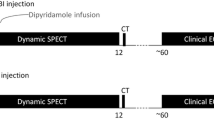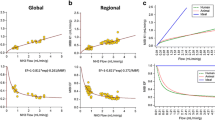Abstract
Background
Quantification of myocardial blood flow (MBF) and myocardial flow reserve (MFR) has shown diagnostic and prognostic values for the assessment of coronary artery disease (CAD). This study aimed to evaluate in patients a highly automatic Yale-MQ (myocardial blood flow quantification) software incorporated with a novel image segmentation approach for quantification of global and regional MBF and MFR from dynamic 82Rb cardiac positron emission tomography (PET).
Methods
Global and regional MBFs and MFRs were quantified in 80 patients (18 normal and 62 CAD subjects) by two different observers using the Yale-MQ software. Lower limits of normal (LLN) values and intra- and inter-observer variabilities of MBFs and MFRs were calculated for the assessment of quantitative precision. The Yale-MQ was compared with a commercially available software (Corridor 4DM) being used as a reference.
Results
The Yale-MQ method provided precise assessments of LLNs of MBF and MFR. The global and regional MBFs and MFR quantified via Yale-MQ were correlated strongly with those via Corridor4DM (R ≥ 0.867). The intra- and inter-observer variabilities of MBFs and MFRs quantified via Yale-MQ were small (≤ 7.7% for MBFs and ≤ 10.0% for MFRs) with excellent correlations (R ≥ 0.980 for MBFs and R ≥ 0.976 for MFRs).
Conclusions
The new Yale-MQ software associated with the automatic processing scheme provides a highly reproducible clinical tool for precise quantification of MBF and MFR in patients with reliable LLN values.






Similar content being viewed by others
Abbreviations
- CI:
-
Confidence interval
- CV:
-
Coefficient of variation
- ICC:
-
Intraclass correction coefficient
- LLN:
-
Lower limit of normal
- MBF:
-
Myocardial blood flow
- MFR:
-
Myocardial flow reserve
- PVE:
-
Partial volume effect
- SD:
-
Standard deviation
- TAC:
-
Time-activity curve
- TNMF:
-
Triple-factor non-negative matrix factorization
References
Ziadi MC. Myocardial flow reserve (MFR) with positron emission tomography (PET)/computed tomography (CT): Clinical impact in diagnosis and prognosis. Cardiovasc Diagn Ther 2017;7:206.
Murthy VL, Bateman TM, Beanlands RS, Berman DS, Borges-Neto S, Chareonthaitawee P, et al. Clinical quantification of myocardial blood flow using PET: Joint position paper of the SNMMI cardiovascular council and the ASNC. J Nucl Cardiol 2018;25:269-97.
Carson RE. Tracer kinetic modeling in PET. Tracer kinetic modeling in PET; 2005. p. 127-59.
Kaster T, Mylonas I, Renaud JM, Wells GA, Beanlands RSB. Accuracy of low-dose rubidium-82 myocardial perfusion imaging for detection of coronary artery disease using 3D PET and normal database interpretation. J Nucl Cardiol 2012;19:1135-45.
Klein R, Beanlands RSB. Quantification of myocardial blood flow and flow reserve: Technical aspects. J Nucl Cardiol 2010;17:555-70.
El Fakhri G, Kardan A, Sitek A, Dorbala S, Abi-Hatem N, Lahoud Y, et al. Reproducibility and accuracy of quantitative myocardial blood flow assessment with 82Rb PET: Comparison with 13 N-ammonia PET. J Nucl Med 2009;50:1062-71.
Klein R, Beanlands RS, Wassenaar RW, Thorn SL, Lamoureux M, DaSilva JN, et al. Kinetic model-based factor analysis of dynamic sequences for 82-rubidium cardiac positron emission tomography. Med Phys 2010;37:3995-4010.
Margadán-Méndez M, Juslin A, Nesterov SV, Kalliokoski K, Knuuti J, Ruotsalainen U. ICA based automatic segmentation of dynamic H2O15 cardiac PET images. IEEE Trans Inf Technol Biomed 2010;14:795-802.
El Fakhri G, Sitek A, Guérin B, Kijewski MF, Di Carli MF, Moore SC. Quantitative dynamic cardiac 82Rb PET using generalized factor and compartment analyses. J Nucl Med 2005;46:1264-71.
Wu J, Liu H, Hashemi Zonouz T, Sandoval VM, Mohy-ud-Din H, Lampert RJ, et al. A blind deconvolution method incorporated with anatomical-based filtering for partial volume correction: Validations with 123I-mIBG cardiac SPECT/CT. Med Phys 2017;44:6435-46.
Liu H, Chan C, Grobshtein Y, Ma T, Liu Y, Wang S, et al. Anatomical-based partial volume correction for low-dose dedicated cardiac SPECT/CT. Phys Med Biol 2015;60:6751.
Liu H, Wu J, Sun JY, Wu TH, Ramesh FC, Thorn S, et al. A robust segmentation method with triple-factor non-negative matrix factorization for myocardial blood flow quantification from dynamic 82Rb positron emission tomography. Med Phys 2019;46:5002-13.
Liu Y-H. Quantification of nuclear cardiac images: The Yale approach. J Nucl Cardiol 2007;14:483-91.
Liu Y-H, Sinusas AJ, DeMan P, Zaret BL, Frans J. Quantification of SPECT myocardial perfusion images: Methodology and validation of the Yale-CQ method. J Nucl Cardiol 1999;6:190-203.
Meyer C, Peligrad D-N, Weibrecht M. Assessment of input function distortions on kinetic model parameters in simulated dynamic 82 Rb PET perfusion studies. Nucl Instrum Methods Phys Res Sect A. 2007;571:199-202.
Klein R, Renaud JM, Ziadi MC, Thorn SL, Adler A, Beanlands RS. Intra-and inter-operator repeatability of myocardial blood flow and myocardial flow reserve measurements using rubidium-82 pet and a highly automated analysis program. J Nucl Cardiol 2010;17:600-16.
Segmentation AHAWGoM, Imaging: RfC, Cerqueira MD, Weissman NJ, Dilsizian V, Jacobs AK, et al. Standardized myocardial segmentation and nomenclature for tomographic imaging of the heart: A statement for healthcare professionals from the Cardiac Imaging Committee of the Council on Clinical Cardiology of the American Heart Association. Circulation 2002;105:539-42.
Yoshinaga K, Manabe O, Tamaki N. Absolute quantification of myocardial blood flow. J Nucl Cardiol 2016;25:1-17.
Lortie M, Beanlands RSB, Yoshinaga K, Klein R, DaSilva JN. Quantification of myocardial blood flow with 82Rb dynamic PET imaging. Eur J Nucl Med Mol Imaging 2007;34:1765-74.
Germino M, Ropchan J, Mulnix T, Fontaine K, Nabulsi N, Ackah E, et al. Quantification of myocardial blood flow with 82 Rb: Validation with 15 O-water using time-of-flight and point-spread-function modeling. EJNMMI Res 2016;6:68.
Altman DG, Bland JM. Measurement in medicine: The analysis of method comparison studies. J R Stat Soc Ser D 1983;32:307-17.
Klein R. Bland-Altman and Correlation Plot; 2019.
Oliveira JB, Sen YM, Wechalekar K. Intersoftware variability impacts classification of cardiac PET exams. J Nucl Cardiol 2019;26:2007-12.
Sdringola S, Johnson NP, Kirkeeide RL, Cid E, Gould KL. Impact of unexpected factors on quantitative myocardial perfusion and coronary flow reserve in young, asymptomatic volunteers. JACC Cardiovasc Imaging 2011;4:402-12.
Manabe O, Yoshinaga K, Katoh C, Naya M, Dekemp RA, Tamaki N. Repeatability of rest and hyperemic myocardial blood flow measurements with 82Rb dynamic PET. J Nucl Med 2009;50:68-71.
Nesterov SV, Deshayes E, Sciagrà R, Settimo L, Declerck JM, Pan X-B, et al. Quantification of myocardial blood flow in absolute terms using 82Rb PET imaging: The RUBY-10 study. JACC Cardiovasc Imaging 2014;7:1119-27.
Wu J, Gallezot J-D, Lu Y, Ye Q, Liu H, Esserman DA, et al. Simplified Quantification and Acquisition Protocol for 123I-MIBG Dynamic SPECT. J Nucl Med 2018;59:1574-80.
Wu J, Lin S-F, Gallezot J-D, Chan C, Prasad R, Thorn SL, et al. Quantitative analysis of dynamic 123I-mIBG SPECT imaging data in healthy humans with a population-based metabolite correction method. J Nucl Med 2016;57:1226-32.
Acknowledgements
The authors would like to thank Mrs. Vera Tsatkin, Dr. Maria Salas, and Mrs. Donna McMahon for their assistance in coordination of the PET/CT imaging protocols, and Drs. Tung-Hsin Wu and Jing-Yi Sun for their helpful discussions in the LV image segmentation.
Author information
Authors and Affiliations
Contributions
HL: data collection, software development, data analysis, manuscript preparation. JW and YHL: study design, data analysis, manuscript preparation. ST, AJS, and EJM: patient recruitments, data collection. RFC and VS: data analysis, critical contribution to the manuscript. All authors read and approved the final manuscript.
Corresponding authors
Ethics declarations
Disclosures
This material was supported by the State of Connecticut under the Connecticut Bioscience Innovation Fund (16-00248, LIU). Its contents are solely the responsibility of the authors and do not necessarily represent the official views of the State of Connecticut or Connecticut Innovations, Inc. No potential conflicts of interest relevant to this work. A grant for creation of a normal PET database (Sinusas) was funded by Invia Medical Imaging Solutions (Ann Arbor, MI).
Additional information
Publisher's Note
Springer Nature remains neutral with regard to jurisdictional claims in published maps and institutional affiliations.
The authors of this article have provided a PowerPoint file, available for download at SpringerLink, which summarises the contents of the paper and is free for re-use at meetings and presentations. Search for the article DOI on SpringerLink.com.
All editorial decisions for this article, including selection of reviewers and the final decision, were made by guest editor Randall Thompson, MD.
Electronic supplementary material
Below is the link to the electronic supplementary material.
Rights and permissions
About this article
Cite this article
Liu, H., Thorn, S., Wu, J. et al. Quantification of myocardial blood flow (MBF) and reserve (MFR) incorporated with a novel segmentation approach: Assessments of quantitative precision and the lower limit of normal MBF and MFR in patients. J. Nucl. Cardiol. 28, 1236–1248 (2021). https://doi.org/10.1007/s12350-020-02278-y
Received:
Accepted:
Published:
Issue Date:
DOI: https://doi.org/10.1007/s12350-020-02278-y




